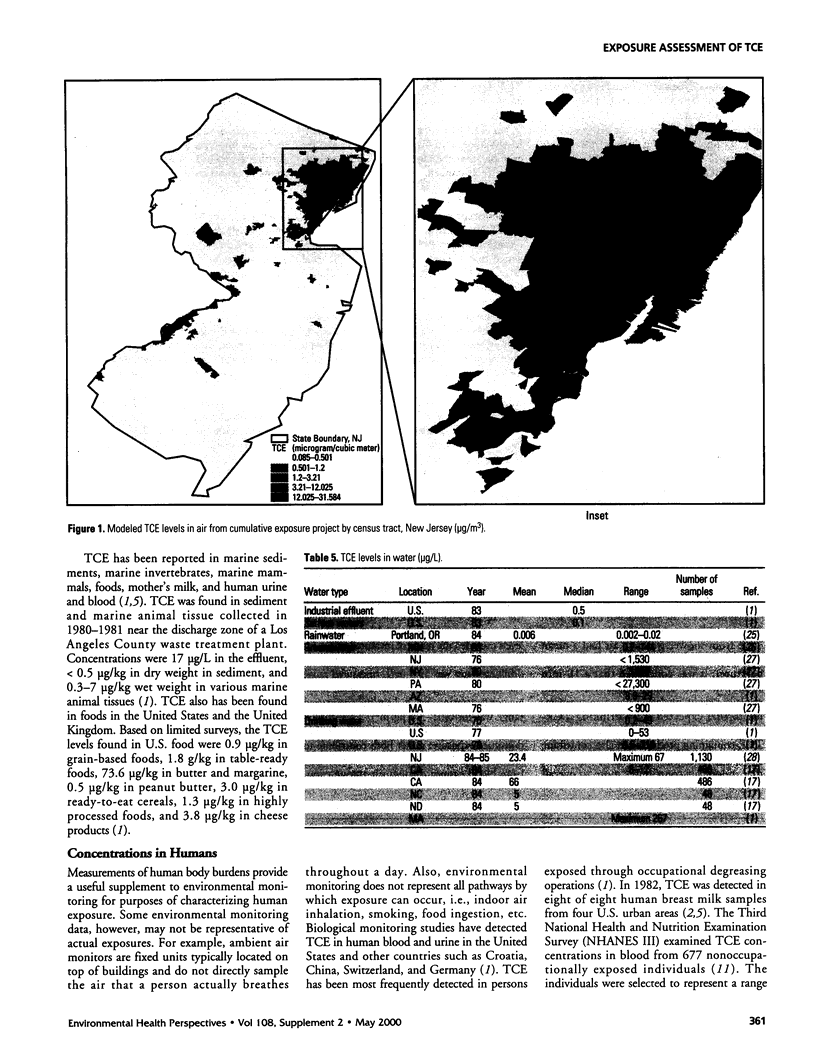Abstract
This article reviews exposure information available for trichloroethylene (TCE) and assesses the magnitude of human exposure. The primary sources releasing TCE into the environment are metal cleaning and degreasing operations. Releases occur into all media but mostly into the air due to its volatility. It is also moderately soluble in water and can leach from soils into groundwater. TCE has commonly been found in ambient air, surface water, and groundwaters. The 1998 air levels in microg/m(3) across 115 monitors can be summarized as follows: range = 0.01-3.9, mean = 0.88. A California survey of large water utilities in 1984 found a median concentration of 3.0 microg/L. General population exposure to TCE occurs primarily by inhalation and water ingestion. Typical average daily intakes have been estimated as 11-33 microg/day for inhalation and 2-20 microg/day for ingestion. A small portion of the population is expected to have elevated exposures as a result of one or more of these pathways: inhalation exposures to workers involved in degreasing operations, ingestion and inhalation exposures occurring in homes with private wells located near disposal/contamination sites, and inhalation exposures to consumers using TCE products in areas of poor ventilation. More current and more extensive data on TCE levels in indoor air, water, and soil are needed to better characterize the distribution of background exposures in the general population and elevated exposures in special subpopulations.
Full text
PDF




Images in this article
Selected References
These references are in PubMed. This may not be the complete list of references from this article.
- Andelman J. B. Human exposures to volatile halogenated organic chemicals in indoor and outdoor air. Environ Health Perspect. 1985 Oct;62:313–318. doi: 10.1289/ehp.8562313. [DOI] [PMC free article] [PubMed] [Google Scholar]
- Ashley D. L., Bonin M. A., Cardinali F. L., McCraw J. M., Wooten J. V. Blood concentrations of volatile organic compounds in a nonoccupationally exposed US population and in groups with suspected exposure. Clin Chem. 1994 Jul;40(7 Pt 2):1401–1404. [PubMed] [Google Scholar]
- Brown H. S., Bishop D. R., Rowan C. A. The role of skin absorption as a route of exposure for volatile organic compounds (VOCs) in drinking water. Am J Public Health. 1984 May;74(5):479–484. doi: 10.2105/ajph.74.5.479. [DOI] [PMC free article] [PubMed] [Google Scholar]
- Clewell H. J., Gentry P. R., Gearhart J. M., Allen B. C., Andersen M. E. Considering pharmacokinetic and mechanistic information in cancer risk assessments for environmental contaminants: examples with vinyl chloride and trichloroethylene. Chemosphere. 1995 Jul;31(1):2561–2578. doi: 10.1016/0045-6535(95)00124-q. [DOI] [PubMed] [Google Scholar]
- Cohn P, Klotz J, Bove F, Berkowitz M, Fagliano J. Drinking Water Contamination and the Incidence of Leukemia and Non-Hodgkin's Lymphoma. Environ Health Perspect. 1994 Jun;102(6-7):556–561. doi: 10.1289/ehp.94102556. [DOI] [PMC free article] [PubMed] [Google Scholar]



